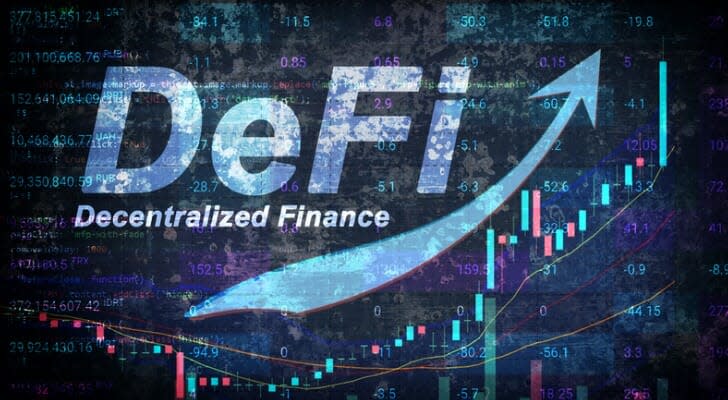What Is DeFi (Decentralized Finance)?
DeFi, short for decentralized finance, is a global, peer-to-peer system of storing and transferring assets without the structure, restriction and costs of a traditional centralized banking system. Advocates assert that DeFi can do everything a bank – whether brick-and-mortar or online-only – can do, only faster and more transparently through digital smart contracts on public ledger blockchains like Ethereum. Here’s what you need to know about this emerging technology. Consider working with a financial advisor if you’re thinking of moving into either cryptocurrencies or using DeFi.
MakerDAO, which was created in 2014, is often credited with being the first DeFi platform to gain widespread use. It’s an open-source project on the Ethereum blockchain and a decentralized autonomous organization created in 2014.
How DeFi Works
DeFi works off a public decentralized blockchain network, stablecoins and DeFi apps, also known as dapps.
Blockchains continuously collect chunks of data and links them so past transactions are immutably and unbreakably documented. Each transaction is publicly verified by everyday users, and once it goes on the chain, it can not be changed. The decentralized nature of blockchain makes it more secure than alternatives that depend on one centralized owner or authority like banks, corporations and governments. Blockchain technology enables the tracking of singular pieces of data like cryptocurrency payments so financial transactions can be verified and traced back to their owners, giving it verifiable value that can be used even more securely than fiat currencies.
Stablecoins are a type of cryptocurrency that aims to combine the transparency, security and immediacy of cryptocurrencies with the stability of fiat currencies.
Most DeFi apps, or dapps, use the Ethereum blockchain to complete transactions. You can purchase Ether, the Ethereum currency, and other cryptocurrencies to spend, lend and save. Cryptocurrencies are what fuel the creation of the blockchain network. Using dapps like Maker, Compound and Bancor, you can pretty much do anything with crypto that you can with traditional currencies like the U.S. dollar, including borrowing and lending. Among other things, you can invest in non-fungible tokens (NFTs), which have been gaining popularity for artists, collectors, celebrities of all kinds and their fans.
Pros and Cons of DeFi
There are some major advantages of using DeFi, including cost, speed and security. Anyone with an internet connection has access to blockchains and cryptocurrencies. Users are able to make trades and move their assets whenever they want without having to wait on bank transfers or pay bank fees. DeFi is fast. The blockchain is updated as soon as a transaction is made, and interest rates are updated multiple times in one minute. The open nature of DeFi means that every single transaction can be seen by the public. It would be very hard to steal cryptocurrency because of how the blockchain logs transactions.
You can also invest on securities markets and conduct peer-to-peer activities. For example, DX.Exchange provides a platform for trading and investing in tokenized stocks backed by NASDAQ and MPS Marketplace Services Ltd. You could buy a house using crypto, provided the seller agrees and you find an abstract company that is willing to work with DeFi. Emerging technologies like BitPay can be used to make purchases for physical goods that are typically paid for in dollars by transferring crypto into cash.
The economic impact of Covid-19 and how banks responded revealed another potential benefit of DeFi. In response to the pandemic’s recession, some central banks slashed interest rates to maintain consumer spending and protect the economy. However, that cut the effective net worth of savers. Under a DeFi regime, a central bank would have a much more difficult – if not impossible – task to manipulate the value of its currency. In other words, DeFi enables users to guard the value of their assets from central bank manipulation.
There are also some disadvantages that DeFi faces. DeFi users are not able to guard the value of their assets from market gyrations. Values fluctuate frequently and sometimes extremely. Ethereum transaction rates also fluctuate, so trading could potentially become expensive. Further, dapps are a relatively new technology and weaknesses or liabilities may yet emerge. In addition, there is also an array of potential tax implications that come with purchasing, trading and investing via DeFi.
Finally, the shape of emerging policies and regulatory schemes have yet to be determined. In particular, it remains to be seen regulators will respond to stablecoins coexisting with central bank digital currencies.
The Bottom Line
DeFi is globalized and permissionless, meaning anyone anywhere has access to funds and other assets at any time, without incurring penalties or fees levied by banks and other traditional financial institutions. Widespread use of DeFi could speed the transition to a cashless society. Hacking might also be reduced. How blockchain technology tracks and secures transactions means it would require a massive coordinated cyber attack to disrupt the chain. This kind of attack is highly improbable and would be challenging to the point that the cost to the attacker would likely outweigh the benefit.
Tips on Investing
Consider talking to a financial advisor about how to get financial exposure to blockchain technology. Finding the right financial advisor doesn’t have to be hard. SmartAsset’s free tool matches you with financial advisors in your area in just five minutes. Get started now.
At this point, securities linked to companies incorporating blockchain-based technologies qualify as an alternative investment, not a core component of a basic investor portfolio. Investing in cryptocurrencies is one way to get financial exposure to blockchain technology. There are several different exchanges to choose from, with the most popular being Coinbase, GDAx and Bitfinex. These exchanges allow you purchase currencies like Bitcoin and Ethereum with a debit card.
Photo credit: ©iStock.com/Vladimir Kazakov, ©iStock.com/http://www.fotogestoeber.de, ©iStock.com/Thinkhubstudio
The post What Is DeFi (Decentralized Finance)? appeared first on SmartAsset Blog.




